COATING TEFLON AND PU COATING
Teflon Coating and PU (Polyurethane) Coating are two types of protective coatings used in various industries to enhance the performance and durability of surfaces. Here’s a breakdown of each:
Teflon Coating:
Composition: Teflon is a brand name for polytetrafluoroethylene (PTFE), a type of fluoropolymer. It is known for its non-stick properties.
Properties:
- Non-stick: It creates a smooth, non-reactive surface that repels sticky substances, making it ideal for cookware and industrial applications.
- Chemical Resistance: It is highly resistant to chemicals, making it useful in corrosive environments.
- Heat Resistance: Teflon can withstand high temperatures, though it does have limits (generally up to about 260°C or 500°F).
- Low Friction: The coating has a low coefficient of friction, which reduces wear and tear on moving parts.
Applications:
- Cookware: Used for non-stick frying pans and baking trays.
- Industrial: Applied to machinery parts, conveyors, and other components where low friction and chemical resistance are beneficial.
- Electronics: Used for insulation on wires and other components.
PU (Polyurethane) Coating:
Composition: Polyurethane coatings are made from a polymer composed of organic units joined by carbamate (urethane) links. They can be formulated as either aliphatic or aromatic types.
Properties:
- Durability: Provides a tough, protective layer that resists abrasion, impact, and weathering.
- Flexibility: PU coatings can be formulated to be flexible or rigid depending on the application.
- Chemical Resistance: Offers good resistance to chemicals and solvents, although not as high as Teflon.
- UV Resistance: Aliphatic PU coatings are UV resistant and maintain their color and finish better over time.
Applications:
- Automotive: Used for protective and decorative finishes on vehicles.
- Construction: Applied to concrete, wood, and metal surfaces to protect against wear and environmental factors.
- Textiles: Used for coatings on fabrics to make them water-resistant or add other properties.



